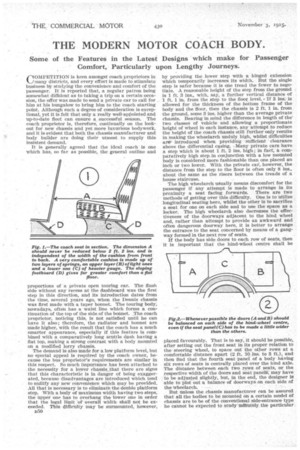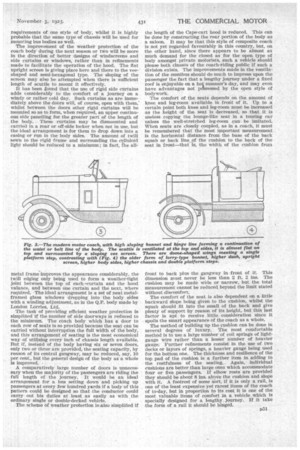THE MODERN MOTOR COACH BODY.
Page 56

Page 57

If you've noticed an error in this article please click here to report it so we can fix it.
Some of the Features in the Latest Designs which make for Passenger Comfort, Particularly upon Lengthy Journeys.
V./ OMPETITION is keen amongst coach proprietors in many districts, and every effort is made to stimulate business by studying the convenience and comfort of the passenger. It is reported that, a regular patron being somewhat diffident as to taking a trip on a certain occasion, the offer was made to send a private car to call for him at his bungalow to bring him to the coach starting point. Although such a degree of consideration is exceptional, yet it is felt that only a really well-apPointed and up-to-date fleet can ensure a successful season. The coach proprietor is, therefore, continually on the lookout for new chassis and yet more luxurious bodywork, and it is evident that both the chassis manufacturer and body builder are doing their utmost to supply this insistent demand.
It is generally agreed that the ideal coach is one which has, so far as possible, the general outline and proportions of a private open touring car. The flush side without any recess at the dashboard was the first step in this direction, and its introduction dates from the time, several years ago, when the Dennis chassis was first made with a taper bonnet. The touring body, nowadays, often has a waist line which forms a continuation of the top of the side of the bonnet. The coach proprietor, noticing this, is not satisfied until he can have it also ; therefore, the radiator and bonnet are made higher, with the result that the coach has a much smarter appearance, especially if this feature is combined with a comparatively long scuttle dash having a fiat top, making a strong contrast with a body mounted on a modified lorry chassis.
The demand is also made for a low platform level, but no special appeal is required by the coach owner, because the bus proprietor's requirements are similar in this respect. So much importance has been attached to the necessity for a lower chassis that there are signs that this characteristic is in danger of being exaggerated, because disadvantages are introduced which tend to nullify any new convenience which may be provided. All that is necessary is to eliminate the double platform step. With a body of maximum width having two steps, the upper one has to overhang the lower one in order that the legal liinit 'of overall width shall not be exceeded. This difficulty may be surmounted, however, D50 by providing the lower step with a hinged extension which temporarily increases, its width. But the single step is safer because it is one tread the fewer tq negotiate. A reasonable height of the step from the ground is 1 ft. 3 ins., with, say, a further vertical distance of 1 ft. 1 in. from the step to the floor level. • If 3 ins is allowed for the thickness of the bottom frame of the body and the floor, then the chassis is 2 ft. 1 in. from the ground, some 3 ins, higher than the average private chassis. Bearing in mind the difference in length of the' two classes of vehicle and allowing a proportionate height of wheel in each instance, any attempt to reduce the height of the coach chassis still further only results in making the wheelarch unduly high, whilst difficulties are introduced when providing sufficient clearance above the differential casing. .Many private cars have a step which is about 1 ft. 2 ins. high ; in fact, k comparatively high step, in conjunction with a low mounted body is considered more fashionable than one placed an inch or two lower. With the private cat', however, the distance from the step to the floor is often only 8 ins., about the same as the risers between the treads of a house staircase.
The high wheelarch usually means discomfort for the passenger if any attempt is made to arrange in its proximity a seat facing forwards. There are two methods of getting over this difficulty. One is to utilize longitudinal seating here, whilst the other is to sacrifice a seat for one on each side and to use the space as a locker. The high wheelarch also decreases the effectiveness of the doorways adjacent to the hind wheel and, rather than attempt to provide an awkward and often dangerous doorway here, it is better to arrange the entrance to the seat concerned by means of a gangway formed in the next row of seats.
If the body has side doors to each row of seats, then it is important that the hind-wheel centre shall be placed favourably. That is to say, it should be possible, after setting out the front seat in its proper relation to the steering wheel, to space out the other rows at a comfortable distance apart (2 ft. 10 ins. to 3 ft.), and then find that the fourth seat panel of a body having sik rows of seats is centrally placed over the hind axle. The distance between each two rows of seats, or the respective width of the doors and seat panels, may have to be adjusted slightly, but, in the end, the designer is able' to plot out a balance of doorways on each side of the wheelarch.
But unless the chassis manufacturer can be assured that all the bodies to be mounted on a certain model of chassis are to be of the conventional side-entrance type he cannot be expected to study -minutely. the particular
requirements of one style of body, whilst it is highly probable that the same type of chassis will be used for mounting bus bodies as well.
The improvement of the weather protection of the coach body during the next season or two will be more in the direction of -better designs of windscreens and side curtains or windows, rather than in refinements made to facilitate the operation of the hood. The flat upright screen is giving place here and there to the veeshaped and semi-hexagonal type. The sloping of the screen may also be attempted when there is sufficient length of scuttle to mount it effectively.
It has been found that the use of rigid side curtains adds considerably to the comfort of a journey on a windy or rather cold day. Such curtains as are immediately above the dobrs will, of course, open with them; whilst between the doors other rigid curtains will be mounted so as to form, when required, an upper continuous side panelling for the greater part of the length of the body. These curtains may be dismounted and carried in. a rear or off-side locker when not in use, but the ideal arrangement is for them to drop down into a casing or run in the body sides. The amount of twill sewn to the rigid frame and surrounding the qlluloid light should be reduced to a minimum ; in fact, the all
metal frame improves the appearance considerably, the twill edging only being used to form a weather-tight joint between the top of each -curtain and the hood valance, and between one curtain and the next, where required. The ideal arrangement is a set of neat metalframed glass windows dropping into the body sides with a winding adjustment, as in the Q.P. body made by London Lorries, Ltd.
The task of providing efficient weather protection is simplified if the number of side doorways is reduced to the minimum. The cbach body which has a door to each row of seats is so provided because the seat can be carried without interruption the full width of the body, and this arrangement of seating is the most economical way of utilizing every inch of chassis length available. But if, instead of the body having six or seven doors, only two or three are provided, the seating capacity, by reason of its central gangway, may be reduced, say, 10 per cent., but the general design of the body as a whole is improved.
A comparatively large number of doors is tumecessary when the majority of the passengers are riding the full length of the journey. It would be an ideal arrangement for a bus setting down and picking up passengers at every few hundred yards if a body of this pattern could be designed so that the conductor could carry out his duties at least as easily as with the ordinary single or double-decked vehicle.
The scheme of weather protection is also simplified if the length of the Cape-cart hood is reduced. This can be done by constructing the rear portion of the body as a saloon. It may be that this style of composite coach is not yet regarded favourably in this country, but, on the other hand, since there appears to be almost as much demand for the closed as for the open type of body amongst private motorists, such a vehicle should please both classes of the coach-riding public if such a division exists. The improvements made in the ventilation of the omnibus should do much to impress upon the passenger the fact that a lengthy journey under a fixed roof is enjoyable on a hot summer's day, and may even have advantages not poiSsessed by the open style of bodywork.
The comfort of the seats depends on the amount of knee and leg-room available in front of it. Up to a certain point both knee and leg-room must be Increased as the height of the seat is decreased, so that it is useless copying the lounge-like seat in a touring car unless the well-stretched leg-room can be imitated. When seats are closely coupled, as in a coach, it must be remembered that the most important measurement is the horizontal distance from the base of the back squab or back line of the cushion to the back of the seat in front—that is, the width of the cushion from front to back plus the gangway in front of it. This dimension must never be less than 2 ft. 2 ins. The cushion may be made wide or narrow, but the total measurement cannot be reduced beyond the limit stated without discomfort.
The comfort of the seat is also dependent on a little backward slope being given to the cushion, whilst the squab should fit into the small of the back and give plenty of support by reason of its height, but this last factor is apt to receive little consideration since it spoils the smart appearance of the coach as a whole.
The method of building up the cushion can be done in several degrees of luxury. The most comfortable method is to use a large number of coil springs of lightgauge Wire rather than a lesser number of heavier gauge. Further refinements consist in the use of two decks or layers of springs, a heavier gauge being used for the bottom one. The thickness and resilience of the top pad of the cushion is a further item in adding to the restfulness of the seating.. Again, individual cushions are better than large ones which accommodate four or five passengers. If elbow rests are provided they should be about 8 ins, above the cushion and slope with it. A footrest of some Sort, if it is only a rail, is one of the least expensive yet rarest items of the coach of to-day, but in proportion to its cost it is one of the most valuable items of comfort in a vehicle , which is specially designed for a lengthy journey. If it take the form of a rail it should be hinged.
















































































